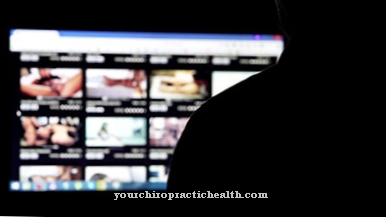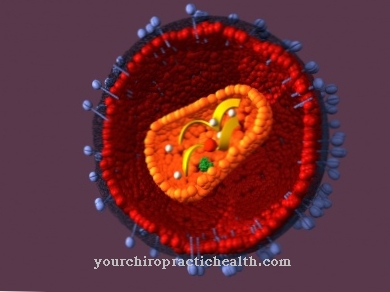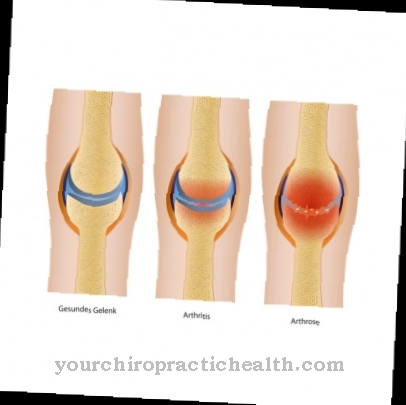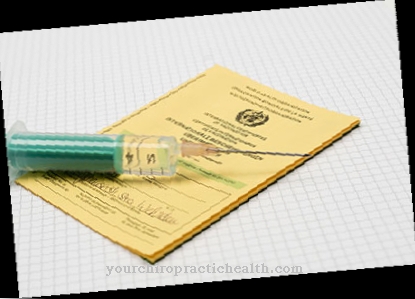The Schöpf-Schulz-Passarge Syndrome is a skin disease. It is very rare and is a hereditary disease. Symptoms in the patient mainly affect the head and face.
What is Schöpf-Schulz-Passarge Syndrome?

© Yevhenii - stock.adobe.com
The Schöpf-Schulz-Passarge Syndrome was named after their discoverers. The German physicians and dermatologists Erwin Schöpf, Hans-Jürgen Schulz and Eberhard Passarge reported this very rare disease for the first time in 1971. The syndrome is a skin disorder caused by a genetic defect.
The hereditary disease primarily causes benign tumors and cysts on the face. In addition, disorders of the tooth systems and body hair are part of the appearance of Schöpf-Schulz-Passarge syndrome. Most of the time, the skin changes appear on the patient's eyelids. In addition, calluses can develop on the hands or feet.
The affected regions are in particular the palms of the hands and the soles of the feet. The Schöpf-Schulz-Passarge syndrome is diagnosed with a frequency of less than 1: 1 million. This makes it a very rare disease that appears shortly after birth, in childhood or adolescence.
causes
The cause of the Schöpf-Schulz-Passarge syndrome is a hereditary genetic defect. The mutation of the WNT10A-GEN leads to various symptoms and ultimately to the diagnosis of the disease. The WNT genes are important in the embryo development phase. The change in the gene is inherited from the parents in an autosomal recessive manner.
As a result, the genetic defect is not necessarily passed on to the children. The outbreak of the disease is automatically prevented if a dominant allele prevails over a recessive allele during the development phase of the embryo in its characteristic expression. It is unclear whether the genetic defect is inherited in an autosomal dominant manner. According to the current state of science, this has not yet been conclusively clarified.
Symptoms, ailments & signs
People with Schöpf-Schulz-Passarge syndrome have cysts on the eyelids. These are mostly described as cylindrical and referred to as apocrine gland cysts. The patients develop benign new tissue formations known as hidrocytomas.
In the middle of the face, the Schöpf-Schulz-Passarge syndrome leads to enlarged capillary vessels in the skin. The so-called telangiectatic rosacea leads to irreversible vasodilatation that is easy to see with the naked eye. Other symptoms of the syndrome include hypotrichosis as well as hypodontia.
Hyptrichosis is a reduced number of hairs in the patient. With Schöpf-Schulz-Passarge syndrome, there can also be a lack of eyelash and eyebrow hair. Hypodontia is a minority of teeth in the sick. This can be one or more teeth that are generally not applied to the patient.
In individual cases, the Schöpf-Schulz-Passarge syndrome leads to nail dystrophy. These are growth disorders on the fingernails or toenails. Patients are also diagnosed with palmoplantar keratosis as they age. These are areas of cornification on the palms of the hands and the soles of the feet.
Diagnosis & course of disease
Most of the symptoms of Schöpf-Schulz-Passarge syndrome are usually recognizable shortly after birth or in the first few weeks of life. After a period of observation and various tests are carried out. The syndrome is eventually diagnosed through a genetic test.
Since some symptoms, such as the lack of teeth and the keratinization of the hands and feet, only become apparent in the first few years of life, further symptoms appear in the patient as the disease progresses.
Complications
First and foremost, those affected by Schöpf-Schulz-Passarge syndrome suffer from serious skin complaints. These occur mainly on the face and can have a very negative effect on the aesthetics and thus also on the quality of life of the person concerned. In many cases, the patients feel uncomfortable because of the symptoms and may also suffer from inferiority complexes or from a significantly reduced self-esteem.
In children or adolescents, the Schöpf-Schulz-Passarge syndrome can also lead to bullying or teasing, so that they suffer from psychological complaints or depression. The nails and teeth are also often negatively affected by this syndrome. On the inner surfaces of the hands, the Schöpf-Schulz-Passarge syndrome leads to early and severe cornification, which can also be associated with pain.
The treatment of Schöpf-Schulz-Passarge syndrome is usually based on the extent of the symptoms. The skin complaints can be alleviated with the help of surgical interventions or laser radiation. Any further complaints to the nails or teeth will also be removed by a doctor. In most cases there are no complications and the disease progresses positively. The life expectancy of the patient is not negatively affected by the Schöpf-Schulz-Passarge syndrome.
When should you go to the doctor?
In the case of Schöpf-Schulz-Passarge syndrome, a doctor should be consulted. The syndrome has a very negative effect on the quality of life of the person affected and can significantly reduce it. To prevent further complications, a doctor should therefore be consulted as soon as possible. Self-healing cannot occur with Schöpf-Schulz-Passarge syndrome, as it is a hereditary disease. A doctor should be seen if the person has cysts on the eyelids. These appear right from birth and do not go away on their own.
Deformations and various malformations in the face of the person affected also indicate the Schöpf-Schulz-Passarge syndrome, something that should always be examined by a doctor. In some cases, the absence of eyelashes or eyebrows also indicates this disease and should then also be examined by a doctor.
In the case of Schöpf-Schulz-Passarge syndrome, first and foremost the family doctor can be seen. Further treatment is then carried out by the respective specialist. As a rule, Schöpf-Schulz-Passarge syndrome does not reduce the life expectancy of those affected. Since the disease can also lead to psychological complaints, a psychologist should also be consulted.
Treatment & Therapy
Treatment of Schöpf-Schulz-Passarge syndrome currently leaves few options. There is no drug therapy or the use of other therapeutic methods for the genetic defect. The treatment therefore consists in the cosmetic removal of the cysts in the face area or the cornifications in the hands and feet.
In the case of nail dystrophy, fingernails and toenails can also be corrected through cosmetic surgery. Depending on the extent of the skin changes, the patient is offered an excision or laser irradiation. The excision is a surgical procedure that removes unwanted tissue.
The surgical procedure is usually carried out with a local anesthetic. If laser irradiation is considered, the cysts are usually removed with a laser in several sessions. The radiation emitted by the laser causes the cysts to be carefully detached from healthy tissue through thermal destruction.
In the case of hypotrichosis, the missing hair can be implanted via a cosmetic procedure if desired. Here too, several sessions are usually to be planned. If the patient suffers from hypodontia, it must be checked whether the tooth gaps can be filled with a denture or whether a remedy can be provided with braces. In most cases, correcting the position of the teeth using an appliance is recommended. In this way, an overall optimization of the misaligned teeth is achieved.
You can find your medication here
➔ Medicines against redness and eczemaprevention
Specific preventive measures cannot be taken in the case of Schöpf-Schulz-Passarge syndrome. It is a hereditary disease in which, according to the current state of science, it is unclear whether the mutated gene is necessarily passed on to the child. Parents could undergo a genetic test in advance, and especially if they want to have children.
They can use this to determine whether they themselves carry the defective gene. In conclusion, the doctor could give you information about how high the probability of inheritance is.
Aftercare
Follow-up care for Schöpf-Schulz-Passarge syndrome initially involves the final treatment of the medical and cosmetic measures. This is often followed by psychological therapy aimed at reducing the risk of depression. There are still no specific preventive measures for the hereditary disease, but a genetic test can reveal how great the risk of the syndrome would be in a child.
The affected patients often suffer from inferiority complexes and have difficulty making social contacts. This is precisely why psychological support following medical therapy is so important. With a trusting relationship with the doctor and loving support from the family, patients feel more comfortable. This trust often begins in advance of the long-term treatment.
To improve the quality of life, it is also worth visiting a self-help group. Contact with other people affected has a positive effect on your own self-confidence and the overall mood. When interacting with people who have the same problem, patients feel accepted and can appear more confident. The mental attitude towards the skin disease therefore plays a major role in aftercare. Once those affected have come to terms with the disease after a while, their quality of life increases automatically.
You can do that yourself
For Schöpf-Schulz-Passarge syndrome, there are only cosmetic treatment methods that cannot be integrated into everyday life. Those affected often feel inferior and try to avoid social contact. It is very important that patients receive mental health care to reduce the risk of depression.
Self-treatment is not possible and spontaneous healing is not to be expected. That is why patients should establish a trusting relationship with their treating doctor. As part of the long-term therapy, the doctor discusses all treatment steps with the patient. The cysts on the face and the cornifications on the extremities are removed cosmetically after intensive consultation.
For a better quality of life, those affected should look for a self-help group. Here you have the opportunity to exchange ideas and gain more self-confidence. There is no direct therapy. That is why it is so important to mentally adapt to the hereditary skin disease. The people who suffer from it often feel more comfortable once they have come to terms with the problem. The involvement of friends and family members also plays an important role. Even children should be supported in this way to concentrate on more important things than their looks.




























